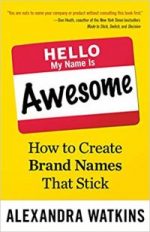Does Your Brand Pass Muster?

Leadership, Professional Development
September 25, 2018
John Thurlbeck
Topics
Alexandra Watkins, brand names, Hello My Name Is Awesome, organizational change, rebrandIn this month’s post, I consider the impact of change on your organisation’s brand.
Are you hidebound by your organisation’s name?
In any economy — local, regional, or national — your brand is everything. It is your reputation 24/7, 365, and it never switches off. However, does your brand work for you, or against you? Should it change as your company evolves? If your company grows, what do you gain or stand to lose by changing your brand?
Those are difficult questions, not least as many organisations have deep historical roots, particularly in the not-for-profit sector. So, whenever an organisation comes through significant change, one consideration may be to rename or rebrand it.
How does a firm but supportive consultant help?
I recently advised a not-for-profit organisation with a 90+ year legacy on this very dilemma. Their previous brand had a particular geographic focus, and the company wished to expand its market horizons while keeping their traditional name.
I raised their dilemma at a meeting of senior executive staff and advised them that, as they were seriously pursuing significant change, then part of their journey had to focus on brand and reputation.
More particularly, on grasping the nettle of a long-held tradition inherent in their organisation’s name. That brand had become outmoded and outdated, hence the organisational change, as well as meaningless to other potential purchasers of their products and services in the broader economy.
My view was clear. If the board wished to expand their horizons, they needed to appeal to those horizons, not the specific locality within which they had traded for decades.
How courageous were they?
They quickly recognised that sustaining and growing an organisation’s fortunes in a volatile market required courage of thought and action — and investment in the future. A significant change was already occurring, and my intervention added a vital piece to that process.
Like any other change process, they also understood that they needed to see the broader opportunity, assess potential risks, and then take decisive action.
What has that to do with brand?
We all know that a powerful brand will drive business. For my clients, their substantial change process provided them with the opportunity to refocus on a rebranding, which helped them not to lose their historical legacy, while giving them a chance to:
- Commit to their new identity — enabling them to grow by being clear-minded about what they did best.
- Translate their strategy into their everyday practice — by building and connecting the cross-functions and capabilities that deliver their strategic intent.
- Put their culture to work — by celebrating and leveraging their cultural strengths, which lay in their history and tradition, reputation, staff team and quality of delivery.
- Invest in growing — by pruning what doesn’t matter to invest more in what does, including their name.
- Shape their future — through reimagining their capabilities, creating demand for their services and realigning their sector on their terms, rather than by other people’s situations and circumstances.
How did they do that with their brand?
In helping them, I ensured that they pursued the Alexandra Watkin’s SMILE test. I briefly describe this below; and for further detail, I highly recommend Alexandra’s book, Hello, My Name is Awesome – How to Create Brand Names That Stick .
If you have led your organisation through significant change and rebranding is an option, you want that brand to be memorable, so here is Alexandra’s short but powerful mnemonic:
S — Suggestive — it evokes something about your brand, about the business that you are in.
M — Meaningful — the name resonates with your audience. It means something to anyone reading the name.
I — Imagery — it evokes imagery of the type of business you are in.
L — Legs — your new name/brand should have mileage, be viable for a long-term period.
E — Emotional — some recent research revealed that emotion drives 50% of every buying decision. Is your name one that engages with people on an emotional level?
How did they do?
I love their new name. It is short, sharp, snappy and describes precisely who their clients are.
The new brand defines the refreshed organisation!
How does yours?






